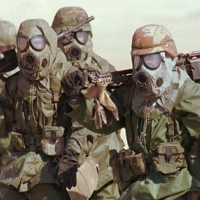George H.W. Bush’s Bombing of Iraqi Chemical Weapons in 1991 may have Exposed U.S. Troops to Health-Threatening Air After All
 Gulf War soldiers wearing M17 gas masks (photo: Richard Kenni, Wikipedia)
Gulf War soldiers wearing M17 gas masks (photo: Richard Kenni, Wikipedia)
Providing critical scientific support to the health claims of thousands of veterans of the 1991 Persian Gulf War, a recently published academic paper shows how nerve agents released by the bombing of Iraqi chemical weapons facilities before the ground assault began could have carried downwind and fallen on U.S. troops in Saudi Arabia.
Almost half of the 700,000 service members deployed for the gulf war have filed disability claims with the Department of Veterans Affairs, and more than 85% of these have been granted benefits. According to a 2008 VA report, about 25% to 32% of Gulf War veterans suffer from “Gulf War syndrome,” a medically recognized condition whose symptoms include chronic pain, memory loss, persistent fatigue and diarrhea.
Published in the journal Neuroepidemiology, the paper refutes the Pentagon position that neurotoxins like sarin gas could not have carried far enough to harm American forces. Skeptics point out that the Pentagon also insisted that the Army had no knowledge of the presence of toxins when it blew up the facilities, until it admitted that was a lie in 1997.
The authors, James J. Tuite and Dr. Robert Haley, pulled together data from meteorological and intelligence reports to show that the American bombs were powerful enough to propel sarin from high into the atmosphere, where winds blew it hundreds of miles to the Saudi border, at which point weather conditions would have stalled the toxic plume and forced it back to the surface. Although initial exposure would have been to low levels of sarin, the exposures could have continued for several days, increasing their impact.
In fact, chemical weapons detectors sounded alarms in those Saudi bivouacs in the days after the depots were destroyed, but many troops ignored them.
Some medical experts still doubt the sarin gas theory, with a few saying the new paper did not change their minds. Dr. John Bailar, an emeritus professor at the University of Chicago who led a study of gulf war illnesses in 1996—before the Pentagon admitted it had been lying about the depots’ destruction—claims there is still no clear evidence that troops might have been exposed to harmful levels of sarin and continues to believe that Gulf War Syndrome is psychological rather than physiological.
Panels of medical experts have gone both ways, with one in 2000 questioning whether low levels of sarin could cause chronic health problems and another in 2004 determining that toxic chemicals have caused neurological damage in many service members.
-Matt Bewig
To Learn More:
Paper Links Nerve Agents in ’91 Gulf War and Ailments (by James Dao, New York Times)
Meteorological and Intelligence Evidence of Long-Distance Transit of Chemical Weapons Fallout from Bombing Early in the 1991 Persian Gulf War (by James J. Tuite and Robert W. Haley, Neuroepidemiology)
Pentagon Now Says It Knew Of Chemical Weapons Risk (by Philip Shenon, New York Times)
Study Describes Gulf War Syndrome as Physical, Not Psychological (by Noel Brinkerhoff and David Wallechinsky, AllGov)
- Top Stories
- Unusual News
- Where is the Money Going?
- Controversies
- U.S. and the World
- Appointments and Resignations
- Latest News
- Trump to Stop Deportations If…
- Trump Denounces World Series
- What If China Invaded the United States?
- Donald Trump Has a Mental Health Problem and It Has a Name
- Trump Goes on Renaming Frenzy






Comments